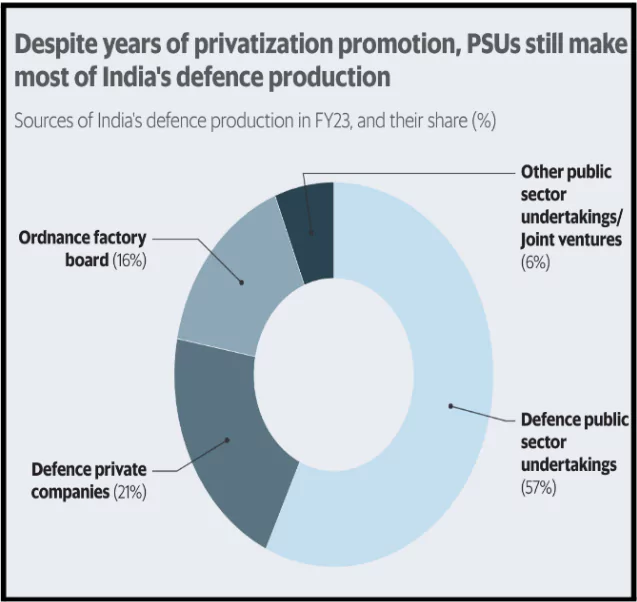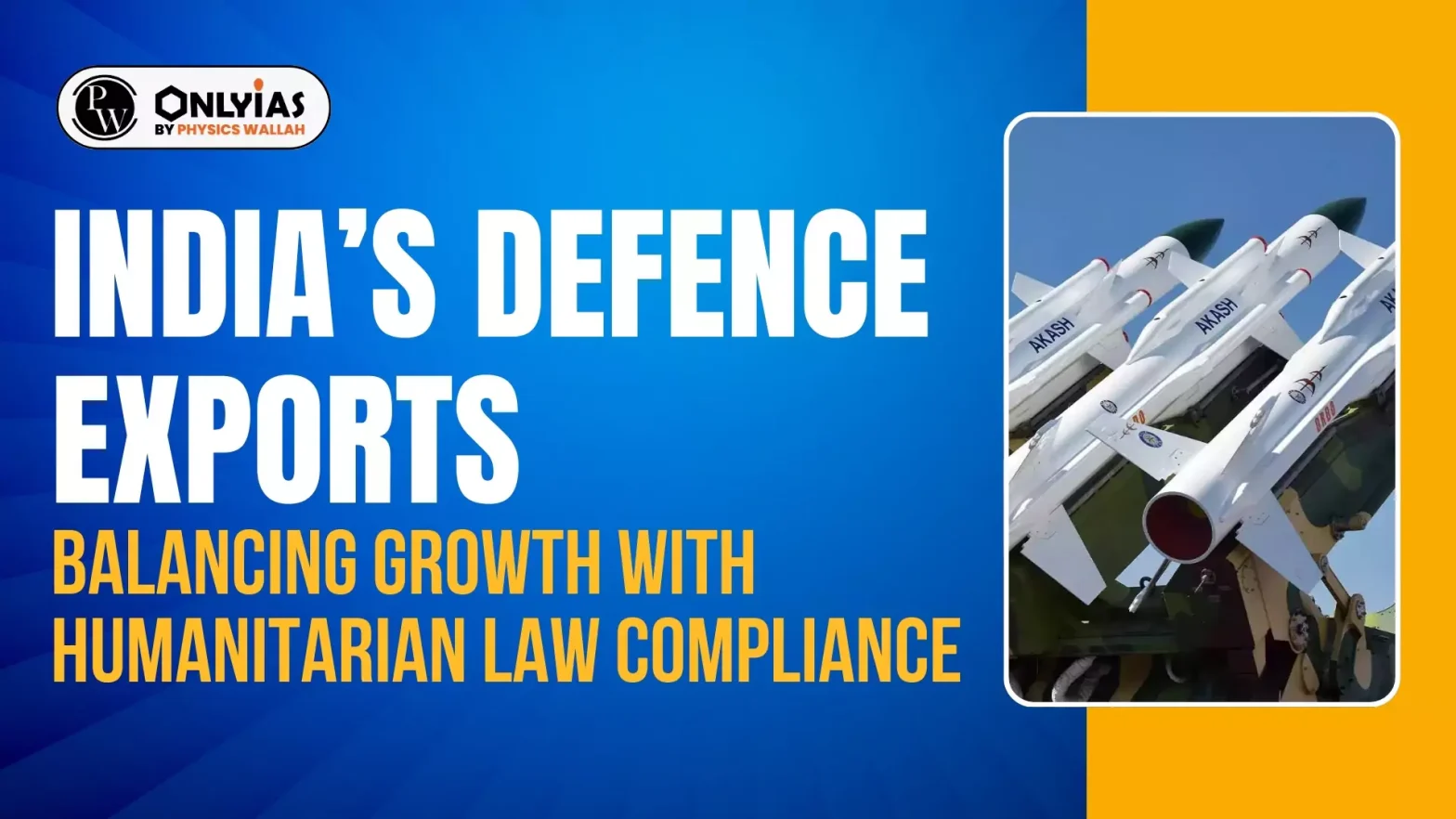The Supreme Court of India dismissed a public interest litigation (PIL) seeking to halt the export of defence equipment to Israel, citing that foreign policy decisions do not fall under its purview.
India’s Defence Exports: Legal and Ethical Concerns Amid International Humanitarian Law Violations
- India is one of the largest importers of arms globally. This presence in the international market raises important legal and ethical questions.
- The Supreme Court’s dismissal of a case on arms exports to Israel, despite war crime allegations, highlights a significant gap in India’s legal system, especially the absence of rules mandating compliance with International Humanitarian Law (IHL) for arms export decisions.
- Several countries, including the Netherlands and the United Kingdom, have restricted or reviewed defence exports to Israel, citing risks of IHL violations in Gaza.
Enroll now for UPSC Online Course
India’s Defence Production and Export Growth
- Defence Production Achievement: India’s defence production reached a record high of ₹1.27 lakh crore in 2023-24.
- Milestone in Defence Exports: Defence exports exceeded ₹21,000 crore for the first time in 2023-24, with military hardware and weapons being supplied to over 90 friendly countries.
- Export Growth Objective: The defence ministry aims to increase exports to ₹50,000 crore within the next five years.
- Turnover Target in Defence Manufacturing: The defence ministry has set a goal of achieving a turnover of USD $billion (₹1.75 lakh crore) in defence manufacturing over the next five years.
- FDI Policy Enhancement: In May 2020, the government raised the FDI limit in the defence sector from 49% to 74% under the automatic route, allowing 100% FDI in specific cases.
|
Legal Gap in Indian Defence Export Laws
- Absence of IHL Compliance Review in Indian Law: Unlike the U.K.’s Export Control Act or EU regulations, India does not have a law mandating the assessment of a country’s compliance with International Humanitarian Law (IHL) before exporting defence equipment.
- Regulatory Provisions in India: However, there are some Acts like India’s Foreign Trade Act (FTA), 1992, and the Weapons of Mass Destruction (WMDA) Act, 2005 that empower the central government to regulate exports for reasons such as national security and international obligations under treaties, covenants, or conventions.
International Arms Trade Law and Its Relevance to India
- Arms Trade Treaty (ATT) : The ATT is a key international agreement regulating the trade of conventional arms, with the goal of preventing weapons from being used to commit serious crimes, including violations of International Humanitarian Law (IHL).
- Provisions of the ATT: Article 6(3), Prohibits arms exports if the exporting country has “knowledge” that the weapons will be used to commit war crimes or other serious violations.
- Article 7: Requires states to assess the risk that exported arms may be used to commit or facilitate serious violations of IHL by the importing country.
- India’s Status: India is not a signatory to the ATT and therefore, its provisions are not legally binding on the country.
- Although the ATT cannot be judicially incorporated in India, some of its principles reflect customary international law, which may still influence legal interpretation.
India’s liability under the International Humanitarian Law (IHL)
- Geneva Conventions: The Geneva Conventions are a set of international treaties that establish standards for humanitarian treatment in war.
- They cover the protection of wounded and sick soldiers, shipwrecked sailors, prisoners of war, and civilians during conflicts
- India ratified the Geneva Convention in 1950, becoming the 5th country in the World and the first country in the region to adopt and implement legislation for the 1949 Conventions.
- Common Article 1 of the Geneva Conventions: It is binding on India and it obligates all states ‘to respect and to ensure respect for IHL.
- International Court of Justice in Nicaragua vs United States: countries are under obligation not to supply weapons to a country, if they violate the Conventions.
|
Check Out UPSC CSE Books From PW Store
Reasons for the Surge in India’s Defence Exports
- India’s Defence Export Strategy: The Defence Production and Export Promotion Policy (DPEPP) aims for US$5 billion in defence exports and US$25 billion in revenue by 2025, supported by frameworks like the Defence Acquisition Procedure 2020 (DAP 2020) helped boost India’s Defence Exports.
- The DPEPP serves as the Ministry of Defence’s guiding document to enhance India’s defence production capabilities for self-reliance and exports.
- Increase in Export Authorisations: A rise in the number of export authorisations from 1,414 in FY23 to 1,505 in FY24 (approx. 6.6% growth) has facilitated more defence exports.
- Government Initiatives: Simplification of export procedures and pro-industry policies have made it easier for companies to engage in defence exports.
- The implementation of the Atma Nirbhar Bharat initiative promotes self-reliance in defence production.
- Policy Reforms: India’s offset policy mandates that foreign defence firms invest a portion of their contract value domestically, boosting exports through joint ventures and technology transfers.
- Increased Domestic Allocation in Defence Budget for FY 2023-24: In FY 2023-24, the allocation of the defence capital procurement budget to domestic industry increased to 75%, compared to 68% in FY 2022-23, resulting in domestic production totaling ₹1.27 trillion.
- Research and Development (R&D): The Defence Research and Development Organisation (DRDO) has allocated ₹23,855 crore for FY 2024-25, enabling the development of exportable products such as the BrahMos missile and the Akash air defence system.
- Strategic Export Partnerships: Notable export deals, such as those with Armenia for Pinaka rockets and Akash air defence missiles, have opened new markets for Indian products.
- Pricing Decisions: Indian defence products are renowned for their quality and competitive pricing. For example, the Akash surface-to-air missile system is significantly cheaper than similar offerings from other nations, attracting buyers like Armenia.
- Private Sector Participation:
- iDEX Initiative: The government promotes private sector participation through the Innovations for Defence Excellence (iDEX) program.
- Surge in Defence Licences: Defence licences issued increased from 215 in 2014 to 440 by March 2019.
- Defence Industrial Corridors: The establishment of Defence Industrial Corridors in Uttar Pradesh and Tamil Nadu enhances a competitive defence manufacturing ecosystem.
Challenges Faced by the India’s Defence sector

- Import Dependence: India is one of the largest arms importers globally, accounting for 9.8% of total global arms imports from 2019 to 2023, according to SIPRI.
- This dependence strains foreign exchange reserves and poses national security risks during geopolitical tensions.
- Lack of Cohesion in Defence Exports: Poor coordination among the Indian Armed Forces, DPSUs (Defence Public Sector Units) private manufacturers, and the Ministry of Defence hinders the promotion of indigenous defence products.
- The absence of a single agency to oversee defence export strategies further complicates the ecosystem.
- Administrative Hurdles: Bureaucratic resistance and outdated practices, hinder private sector integration into defence manufacturing and deter innovation.
- Project Delays: Delays in crucial defence projects and cost overruns due to such delays hamper the growth.
- As per the Ministry of Defence, 23 of 55 DRDO’s ‘mission mode’ projects have been delayed.
- R&D Issues: India’s Gross Expenditure on Research and Development (GERD) is only 0.65%.
- Infrastructure Issues: Infrastructural Deficit increases India’s logistics costs, thus reducing the cost competitiveness and efficiency in the defence sector.
- Slow Procurement Process: The Defence Procurement Procedure (DPP) remains complicated and inefficient.
- Challenges of India’s Offset Policy: India’s offset policy mandates a minimum obligation of 30% of the estimated cost for defence contracts exceeding Rs 2,000 crore.
- However, foreign vendors remain sceptical about the Indian industry’s capacity to absorb offsets worth billions of dollars.
- Low Private Sector Participation: The private sector still contributed only 22% in FY24.
- Technological Disparity: India faces significant challenges in critical areas such as advanced materials, high-end electronics, and propulsion systems, which are essential for modern defence capabilities.
Check Out UPSC NCERT Textbooks From PW Store
Possible Call of Actions to Boost the Indian Defence Sector
- Need for Legislative Amendments: India should amend the WMDA and FTA to explicitly include an assessment of the IHL compliance of countries importing its defence goods.
- This proactive step will enhance India’s reputation as a responsible defence-exporting nation and align its export policies with International Humanitarian Law (IHL).
- Defense Lines of Credit and Interest Rates: Implementing Defense Lines of Credit in proposals can enhance competitiveness by providing financial support to foreign buyers, while reducing interest rates will make Indian defence products more attractive to international markets.
- Framework for International Sales: Establishing a clear framework for international sales will facilitate smoother and more efficient transactions, promoting transparency and consistency in defence exports while attracting potential buyers.
- Technology Development Fund (TDF)
- The TDF scheme, managed by the Defence Research and Development Organisation (DRDO), supports the Indigenous development of defence technologies by Indian industries, particularly startups and MSMEs.
- Innovations for Defence Excellence (iDEX)
- Launched in May 2021, iDEX is an initiative under the Defence Innovation Organization (DIO) aimed at fostering innovation in defence and aerospace by engaging startups and MSMEs.
- The scheme operates through challenges like the Defence India Startup Challenges (DISC) and the Open Challenge, promoting innovative solutions for defence needs.
|
- Revamp of the Offset Policy: India should revamp its offset policy by establishing a dedicated offset management agency and creating a transparent online platform to align offset requirements with export-oriented projects, focusing on technology transfer and co-development.
- Reduce Duplication of Efforts: Efforts to streamline indigenization and innovation through collaboration between the Defence Research and Development Organisation’s (DRDO) Technology Development Fund (TDF) scheme and the Innovations for Defence Excellence (iDEX) scheme by the Defence Innovation Organisation (DIO) are essential.
- Establishing a Defense Export Promotion Agency: The government should create a Defense Export Promotion Agency (DEPA) under the Prime Minister’s Office to coordinate defence exports effectively, enhancing synergy among armed services, public and private manufacturers, and foreign partners
- Avoiding autarkic defence production: In its pursuit of Atmanirbhar Bharat, India must avoid an autarkic defence production model, whereby a country stops collaborating with external governments, manufacturers, and scientists for technology.
Enroll now for UPSC Online Classes
Conclusion
India’s defence exports must be aligned with humanitarian law to ensure that military supplies do not contribute to human rights violations.
- By prioritising ethical considerations in arms trade, India can enhance its reputation as a responsible global player while fostering regional stability.
![]() 26 Sep 2024
26 Sep 2024


